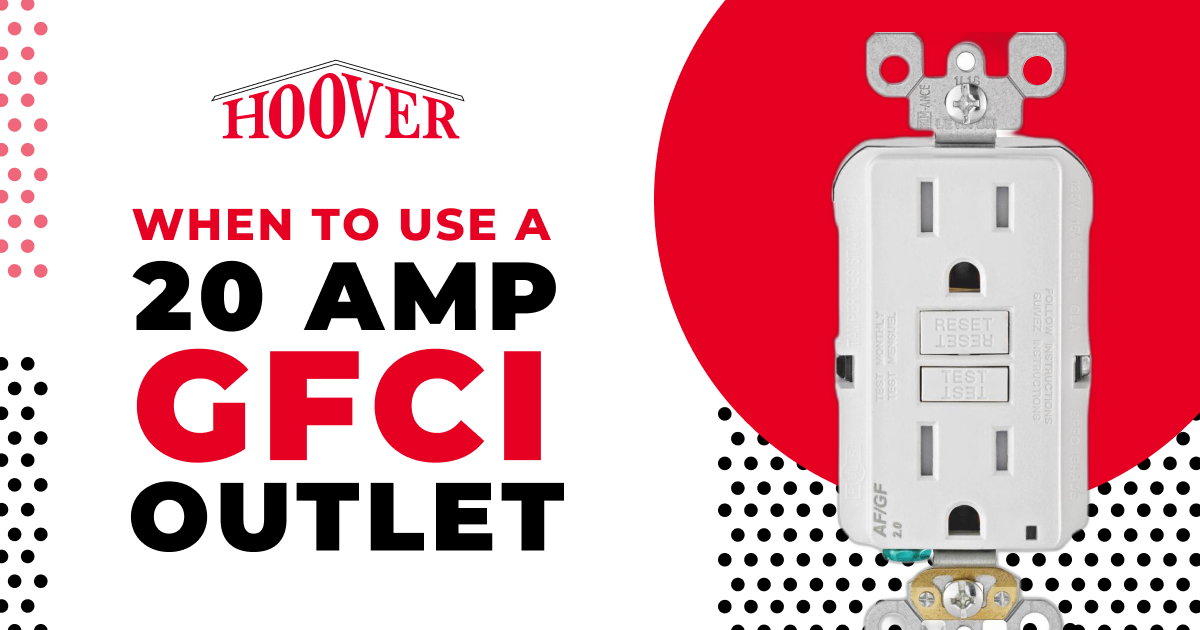
A 20 Amp GFCI outlet is used to plug in high-power appliances. It can draw up to 2,400 Watts compared to a 15 Amp outlet that can draw up to 1,800 Watts. We’ll explain when and where to use a 20 Amp outlet, how to identify one, and how to know you need this type of GFCI outlet installed by an electrician.
Where You’ll Find a 20 Amp GFCI Outlet
A GFCI outlet, or ground fault circuit interrupter, protects against shock if there’s an imbalance in the current flowing through it, such as when an appliance is exposed to water. It won’t protect against overloading or stop fires, so it works alongside other components like circuit breakers. Nevertheless, you’ll find a 20 Amp GFCI outlet in:
- Kitchens: Refrigerators, blenders, microwave ovens, and other high-power kitchen appliances.
- Garages: Drills, saws, air compressors, and other types of power tools and heavy equipment.
- Bathrooms: Bathrooms with only one electrical outlet must have a 20 Amp rated GFCI, for example, to power a hairdryer.
A 20 Amp GFCI can transmit more power, so you can use it to either run a high-power appliance or connect multiple devices or appliances.
How to Identify a 20 Amp GFCI Outlet
A 20 Amp outlet has three slots like a 15 Amp outlet. These include two vertical slots for hot wires and a slot for the neutral wire. However, the 20 Amp outlet has a T-shaped neutral slot. It is designed to fit the horizontal neutral pin on a 20 Amp plug.
Can I Insert a 15 Amp Plug Into a 20 Amp Socket?
Both 15 Amp and 20 Amp plugs are the same size. Therefore, a 15 Amp plug will fit into a 20 Amp socket. They also both have GFCI protection. But since the T-shaped slot is rotated 90°, you can’t put a 20 Amp plug into a 15 Amp outlet. This is a good thing, as the higher power load will easily overwhelm a 15 A circuit.
The National Electrical Code (NEC) prohibits the use of outlets that exceed the rating of the circuits they’re connected to. You can safely run a 15 A GFCI on a 20 A circuit because it has lower power requirements. Conversely, using a 20 Amp GFCI on a 15 Amp circuit (if it were possible) would draw more power than it can handle, causing the breaker to trip. And if the breaker doesn’t work, the excessive load can start a fire.
Wiring Requirements
While 15 Amp circuits require a 14-gauge wire, 20 Amp circuits should have a 12-gauge wire (a 10-gauge wire can be used to cover a longer distance). The lower the gauge number, the larger and thicker the wire and the more power it can transmit.
About Circuit/GFCI Ratings
When selecting the proper outlet, you’ll need to know its rating. The types of ratings that apply to home electrical outlets include the:
- Circuit Rating: It’s unlikely you’ll need an outlet that’s more than 20 Amps in a residential setting. Home outlets are typically either 15 Amps or 20 Amps.
- GFCI Rating: The amp rating of the GFCI outlet must match the amp rating of the circuit. If the circuit is rated for 20 Amps, only 20 Amp outlets should be installed.
To find an outlet’s rating, check for a label indicating its maximum amperage. You can also go to the electrical panel and find the breaker for the circuit. A marking on the breaker will tell you its amp rating.
How to Know You Need a 20 Amp GFCI Outlet
You’ll need to know the total draw of all the appliances connected to the circuit. Most appliances are rated in watts. But a wattage rating differs from an amp rating. You can’t compare them directly. First, you need to add up the amperage ratings of the appliances you plan to use on the circuit. Then, identify the amperage rating of the GFCI and multiply it by the voltage of your power supply (in most homes, this is 120 Volts).
That’s why a 20 Amp GFCI can handle 2,400 Watts. However, the NEC recommends using only 80% of a circuit’s maximum capacity. That means using just 1,920 Watts to account for increases in power demand during device startups and surges.
Following this principle will ensure you never install the wrong amperage GFCI. A simpler way to do this is to replace an ordinary outlet with a GFCI of the same capacity.
Call Hoover Today
There need not be any guesswork when installing a 20 Amp GFCI outlet. At Hoover Electric, Plumbing, Heating & Cooling, our licensed electrical technicians can determine where you need a 20 Amp outlet and perform all the calculations for you. They’ll also help assess your electrical needs, select the best location for outlets, and install, repair, or replace GFCIs. Each outlet is tested to ensure it’s functional and safe to use. To learn more about 20 Amp GFCI outlets or to schedule service, call 586-701-6127 today.


